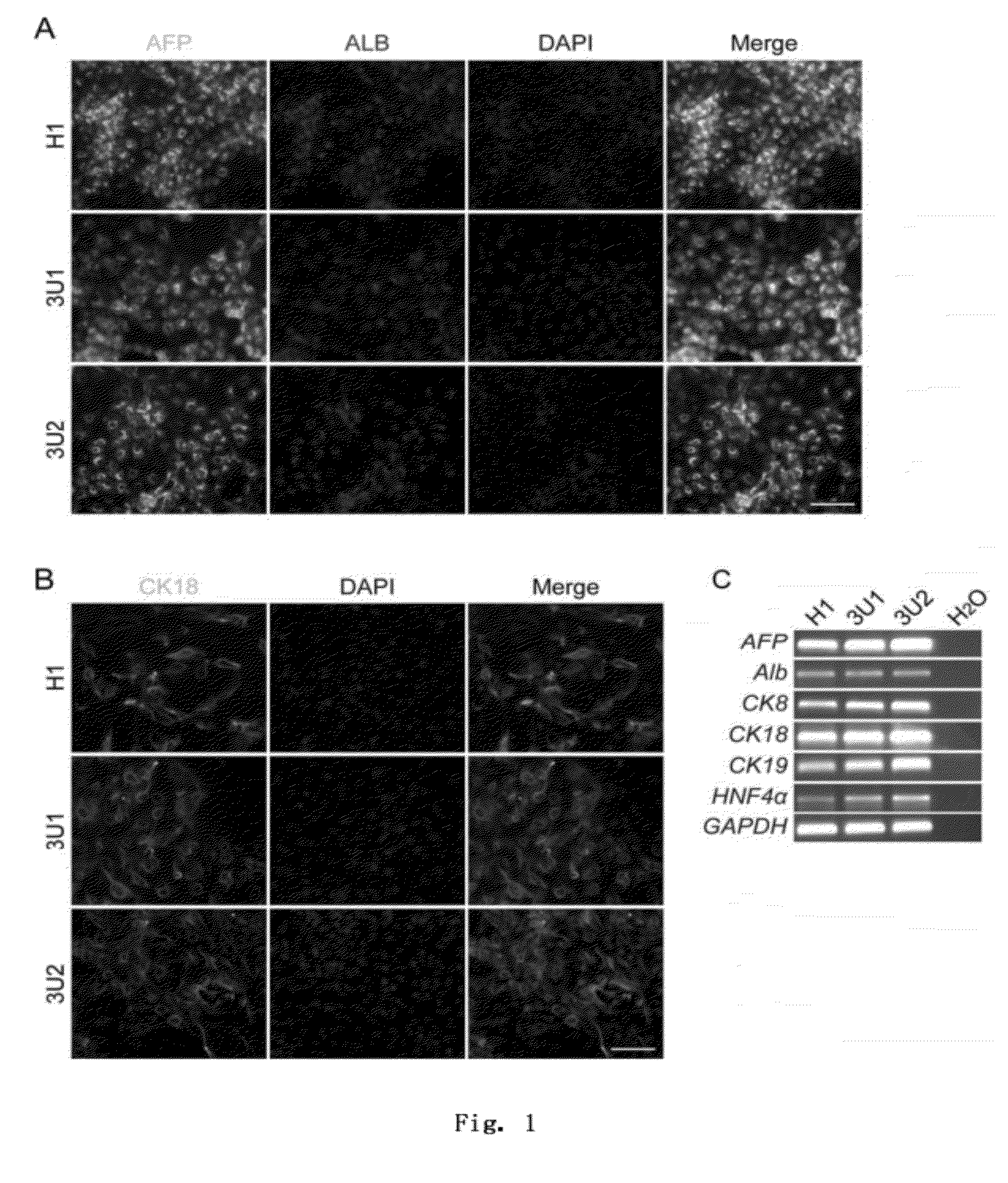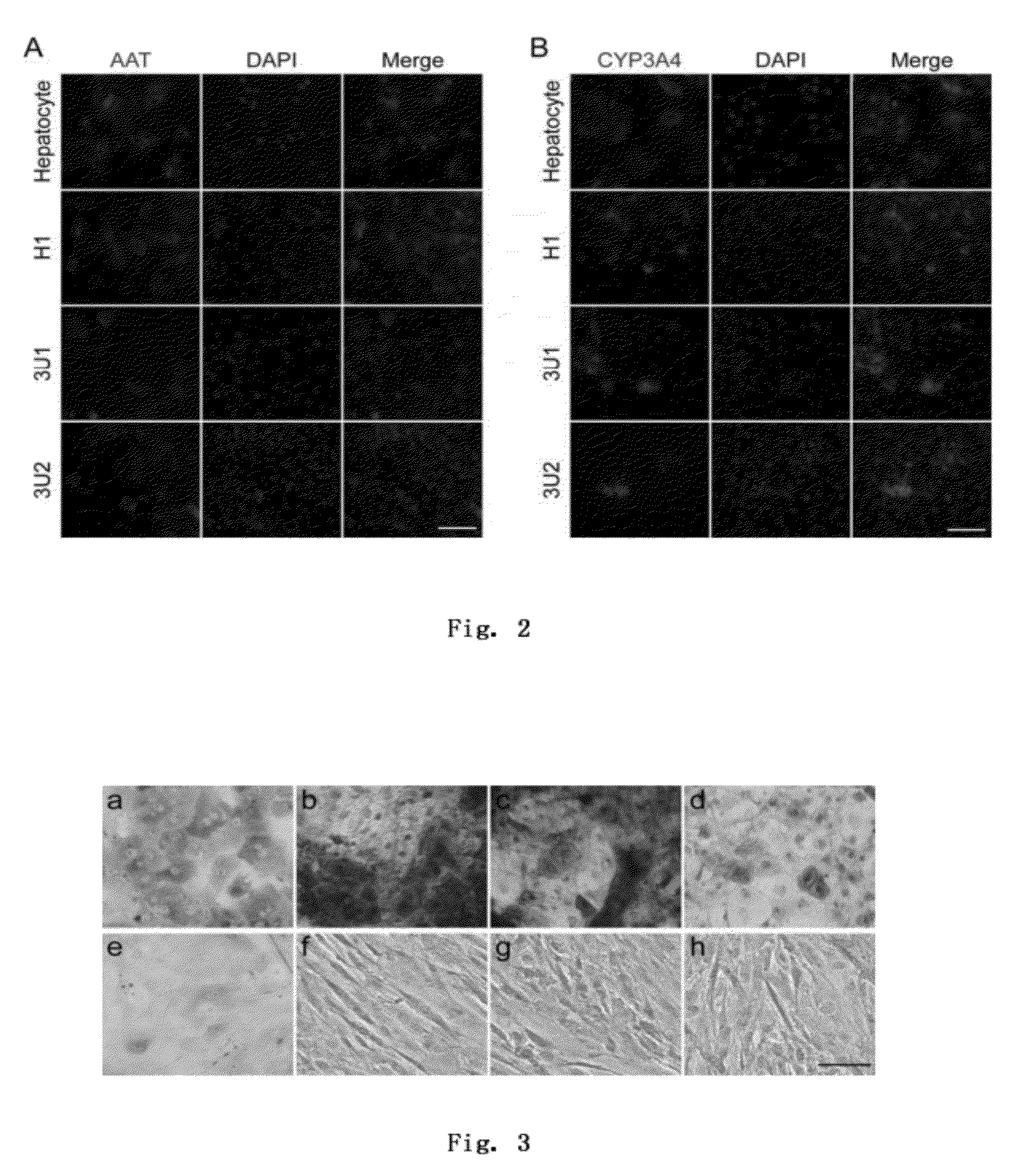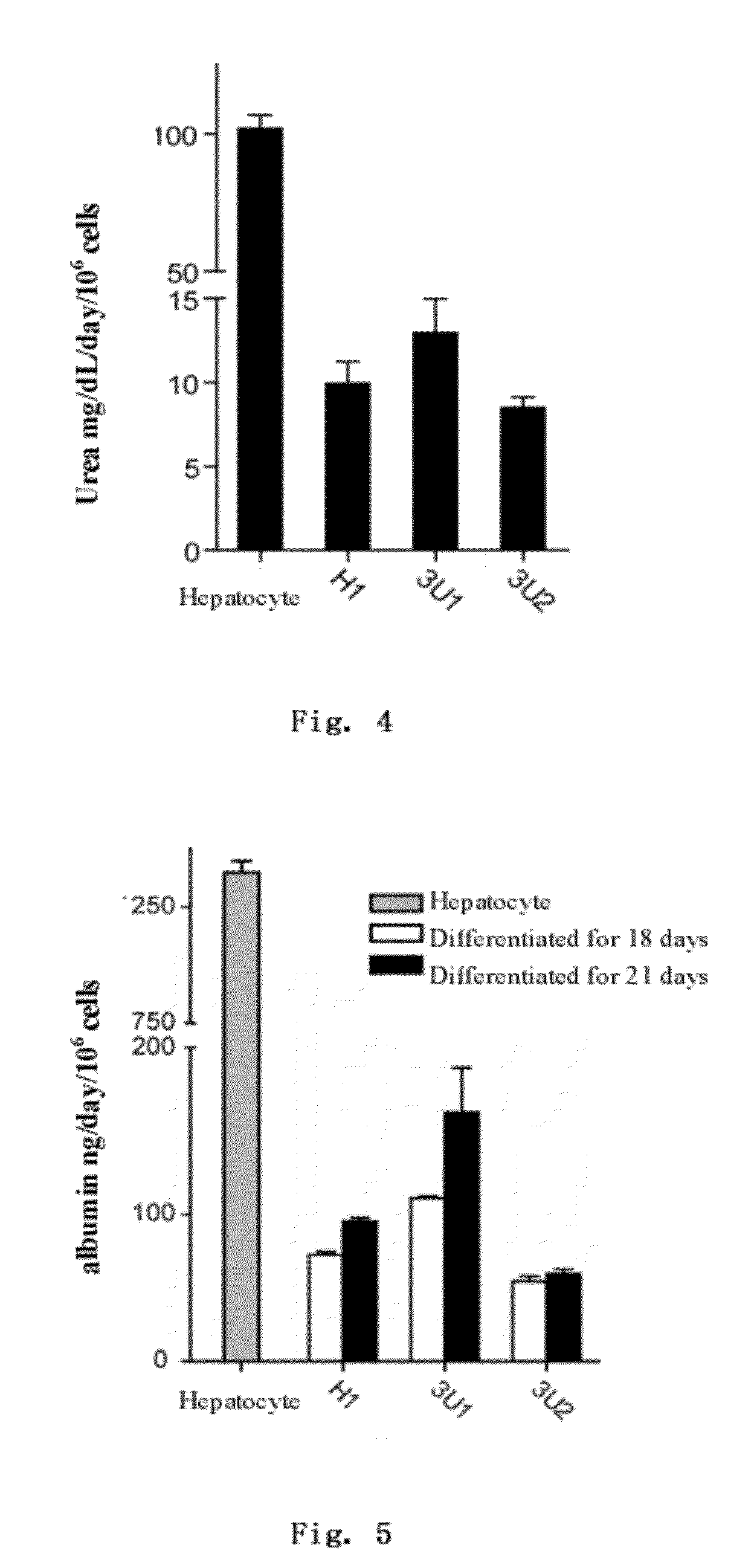Methods for obtaining hepatocytes, hepatic endoderm cells and hepatic progenitor cells by induced differentiation
a technology of hepatic progenitor cells and hepatocytes, which is applied in the field of obtaining hepatocytes, hepatic endoderm cells and hepatic progenitor cells by induced differentiation, can solve the problems of limiting the investigation in this field, the origin and function of these hepatic progenitor cells are still questionable, and achieves strong proliferation ability
- Summary
- Abstract
- Description
- Claims
- Application Information
AI Technical Summary
Benefits of technology
Problems solved by technology
Method used
Image
Examples
example 1
Induction and Detection of Differentiation of Human ES Cells or IPS Cells into Hepatocytes
I. Conventional Cultivation of Human ES Cells or iPS Cells
(1) Reagents
[0205]PBS: 8g NaCl, 0.2 g KCl, 1.44 g Na2HPO4 and 0.24 g KH2PO4 were weighted; to which ddH2O (double distilled water) was added to reach a final volume of 1000 mL; and pH value was adjusted to 7.4 by HCl.
[0206]2M β-mercaptoethanol (20000×): 1 mL of 14.3M β-mercaptoethanol was diluted with 6.15 mL PBS, and sterilized by filtering.
[0207]human iPS cell culture medium (HESM): 20% Serum Replacement (Knock-out Serum Replacement, KSR), 1 mM glutamine (Gibco Co. USA), 0.1 mM β-mercaptoethanol, 1% nonessential amino acid (Non-essential AminoAcids, Gibco Co. USA), and 10 ng / mL basic fibroblast growth factor (bFGF) were mixed in DMEM / F12(Invitrogen Co. USA) to a final volume of 1000 mL.
[0208]0.5 mg / mL Dispase (Gibco Co. USA): 10 mg Dispase powder was weighted and dissolved in 20 mL DMEM / F12 medium, then sterilized by filtering.
[0209]1 ...
example 2
Preparation and Identification of Hepatic Endoderm Cells
I. Obtainment of Hepatic Endoderm Cells
[0278]Day 1:
[0279]1) induction of human embryonic stem cells H1, H7 or H9 started at 2-3 days after passage, and the cells in good growth state were selected to be subjected to the differentiation experiment;
[0280]2) human embryonic stem cell culture medium (i.e. basic cell culture medium DMEM / F12 supplemented with 20% serum replacement (Knock-out Serum Replacement, KSR, Invitrogen Co. USA, 10828028), 1 mM glutamine (Invitrogen Co. USA, 25030-081), 0.1 mM β-mercaptoethanol (Invitrogen Co. USA, 21985-023), 1% nonessential amino acid (Non-essential AminoAcids)(Invitrogen Co. USA, 11140-076), 4 ng / mL basic fibroblast growth factor (bFGF, Peprotech Co. USA, 100-18B)) was discharged, and the cells were washed twice with PBS;
[0281]3) endoderm inducing medium I, i.e. RPMI1640 medium supplemented with bovine serum albumin component V (Calbiochem Co. USA, 126579) and human activin A (Activin A, Pep...
example 3
Preparation of Hepatic Progenitor Cells from the Hepatic Endoderm Cells Derived from Human Embryonic Stem Cells
[0306]I. Generation of Hepatic Progenitor Cells from Hepatic Endoderm Cells
[0307]A) Obtainment of Hepatic Progenitor Cells
[0308]1) the hepatic endoderm cells obtained in Example 2 was washed once with PBS;
[0309]2) if N-cadherin sorting was not performed, then digestion was carried out with trypsin-EDTA solution at room temperature for 1 min; if N-cadherin sorting was desired, then digestion was carried out with EDTA-free trypsin (trypsin solution added with 2 mM CaCl2) at 37° C. for about half an hour;
[0310]3) digestion was terminated by adding DMEM medium containing 10 (v / v) % fetal bovine serum, and the cells were suspended and transferred into a 15 ml centrifuge tube;
[0311]4) the cells were centrifuged at 1000 rpm for 5 min and resuspended in a hepatic progenitor cell culture medium, i.e. DMEMIF-12 basic culture medium supplemented with HEPES (Calbiochem Co. USA, 391338)...
PUM
| Property | Measurement | Unit |
|---|---|---|
| concentration | aaaaa | aaaaa |
| concentration | aaaaa | aaaaa |
| volume ratio | aaaaa | aaaaa |
Abstract
Description
Claims
Application Information
 Login to View More
Login to View More - R&D
- Intellectual Property
- Life Sciences
- Materials
- Tech Scout
- Unparalleled Data Quality
- Higher Quality Content
- 60% Fewer Hallucinations
Browse by: Latest US Patents, China's latest patents, Technical Efficacy Thesaurus, Application Domain, Technology Topic, Popular Technical Reports.
© 2025 PatSnap. All rights reserved.Legal|Privacy policy|Modern Slavery Act Transparency Statement|Sitemap|About US| Contact US: help@patsnap.com



